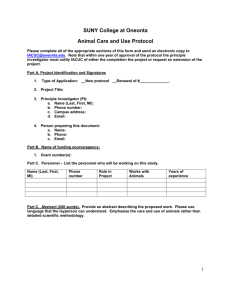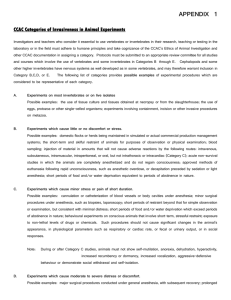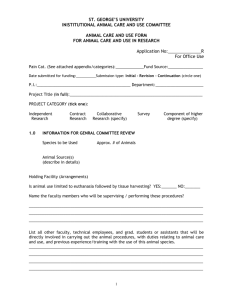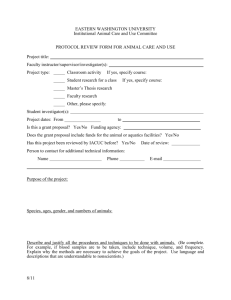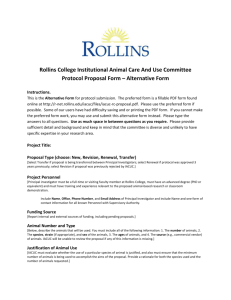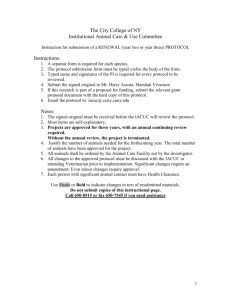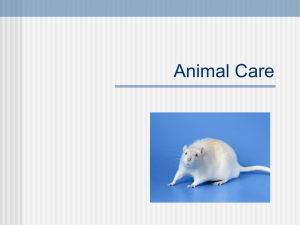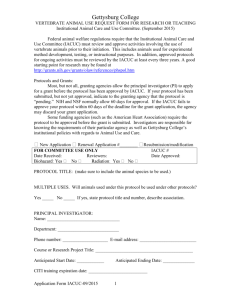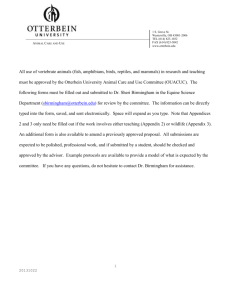EH&S USE ONLY - University of Wisconsin
advertisement
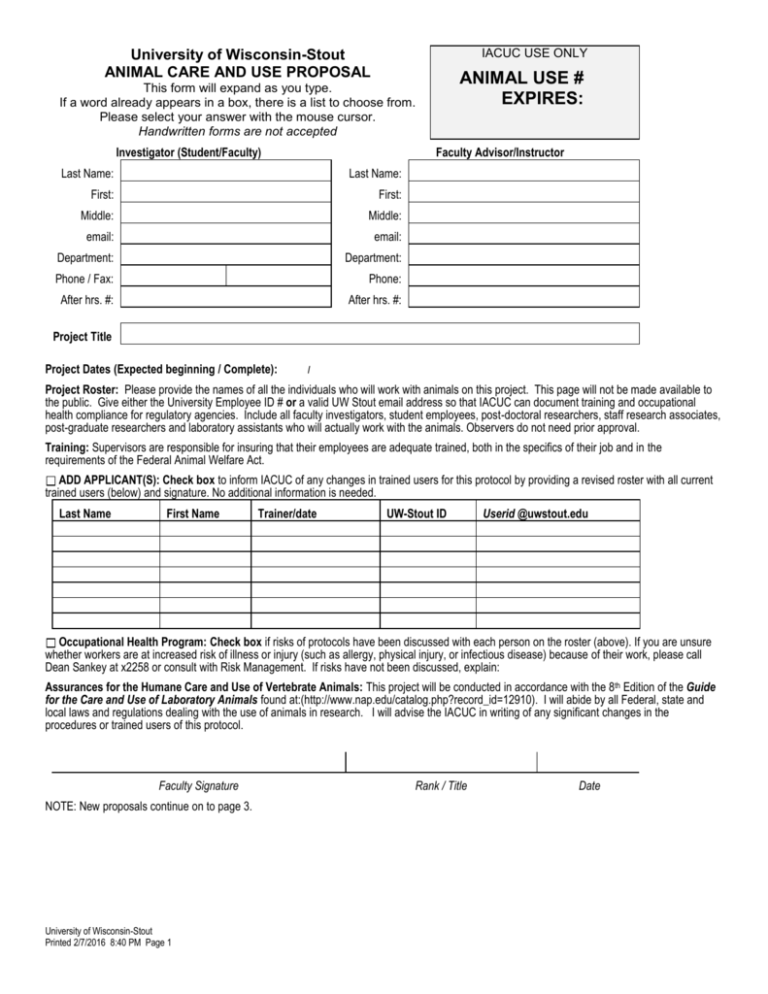
IACUC USE ONLY University of Wisconsin-Stout ANIMAL CARE AND USE PROPOSAL ANIMAL USE # EXPIRES: This form will expand as you type. If a word already appears in a box, there is a list to choose from. Please select your answer with the mouse cursor. Handwritten forms are not accepted Investigator (Student/Faculty) Faculty Advisor/Instructor Last Name: Last Name: First: First: Middle: Middle: email: email: Department: Department: Phone / Fax: Phone: After hrs. #: After hrs. #: Project Title Project Dates (Expected beginning / Complete): / Project Roster: Please provide the names of all the individuals who will work with animals on this project. This page will not be made available to the public. Give either the University Employee ID # or a valid UW Stout email address so that IACUC can document training and occupational health compliance for regulatory agencies. Include all faculty investigators, student employees, post-doctoral researchers, staff research associates, post-graduate researchers and laboratory assistants who will actually work with the animals. Observers do not need prior approval. Training: Supervisors are responsible for insuring that their employees are adequate trained, both in the specifics of their job and in the requirements of the Federal Animal Welfare Act. ADD APPLICANT(S): Check box to inform IACUC of any changes in trained users for this protocol by providing a revised roster with all current trained users (below) and signature. No additional information is needed. Last Name First Name Trainer/date UW-Stout ID Userid @uwstout.edu Occupational Health Program: Check box if risks of protocols have been discussed with each person on the roster (above). If you are unsure whether workers are at increased risk of illness or injury (such as allergy, physical injury, or infectious disease) because of their work, please call Dean Sankey at x2258 or consult with Risk Management. If risks have not been discussed, explain: Assurances for the Humane Care and Use of Vertebrate Animals: This project will be conducted in accordance with the 8th Edition of the Guide for the Care and Use of Laboratory Animals found at:(http://www.nap.edu/catalog.php?record_id=12910). I will abide by all Federal, state and local laws and regulations dealing with the use of animals in research. I will advise the IACUC in writing of any significant changes in the procedures or trained users of this protocol. Faculty Signature NOTE: New proposals continue on to page 3. University of Wisconsin-Stout Printed 2/7/2016 8:40 PM Page 1 Rank / Title Date Committee Use Only Below ** Conditions necessary for Committee Approval: Final Disposition of this protocol: Approved Not Approved Withdrawn by Investigator Date of Action: End Date: I verify that the Institutional Animal Care and Use Committee of the University of Wisconsin-Stout acted on this protocol as shown above. IACUC Representative University of Wisconsin-Stout Printed 2/7/2016 8:40 PM Page 2 Date Provide the following information on project support. Proposed or Awarded Cooperative Research*, Extramural Funding please describe below Proposed or Awarded Classroom Project or Intramural Funding Demonstration, please describe below Un-sponsored Research or Other, please describe below *Cooperative Research is research carried out in collaboration with another institution. All cooperative research involving animals must have UW-Stout IACUC approval regardless of where the animals are housed. If cooperative research, classroom project, un-sponsored research, or other, please describe Funding Information (fill out EITHER 1, 2, or 3 below; not all): 1) Proposed, Awarded, Intramural, or Cooperative Research: Award Agency Award Title: Award Number: Awarded Project Dates 2) Classroom Projects or Demonstrations require approval of the Departmental Curriculum Committee or Department Chair: (Department) (Signature of Committee/Department Chair) (Date Approved) 3) Un-sponsored Research or Other (review required by two faculty): I have reviewed the attached animal care and use project proposal and find it to be scientifically valid and consistent with UW-Stout policies. (Name of Faculty Reviewer) (Signature of Faculty Reviewer) (Date Approved) Study Groups and Numbers: Define the numbers of animals to be used for each objective/experimental group in the rows of the table below; you may add as many rows as you require. The chart must fully account for the number of animals you intend to use for this project. Assign each group to an invasiveness category (listed at end of form) according to the chart below. Objective/Group Description of Procedure/Protocol Number and Rationale* Number of Animals Invasiveness category *Rationale for choice of species: How did you determine that the species choice was appropriate? *Rationale for numbers of animals used: How did you determine that the number of animals in each study groups was the minimum number necessary to achieve sound scientific results? Indicate the statistical analysis tests that were done. University of Wisconsin-Stout Printed 2/7/2016 8:40 PM Page 3 Animal Protocol Requirements and Facilities where protocol will be performed: Animal Information Facilities Information Species (common names): Housed in: (Bldg / Room) Strain: Room: Source: Maintained by user(s)*: wild / lab bred (circle one)? Adults used/year (for experiments): Embryos used/year (for experiments): / *If day use only, enter “day use only.” Animals used in (Bldg / Room): / Special Husbandry Requirements for project: Describe any project-specific requirements your animals have with respect to food (live or dry), water, temperature, humidity, light cycles, caging type, bedding, or any other conditions of husbandry. Other instructions for animal care (check all that apply): Sick Animals Dead Animals Call Student/Faculty Applicant Call Student/Faculty Applicant Clinician to treat Save Terminate Bag for disposal Necropsy Necropsy Pest Control Call Student/Faculty Applicant OK to use pesticides No Pesticides in animal area Veterinary care: Check box if our local or attending veterinarian has been notified that protocols included in the project require veterinary care and please explain. Veterinarian providing animal care: Veterinarian: Address: Day phone: Emergency phone: Email: Animal Use Overview: In a short paragraph (about 100-200 words), present the overall intent of the study. Include in your description a statement of your hypothesis, the objectives and significance of the study- indicate how this study is relevant to advancing scientific knowledge, animal or human health, or the good of society. Your target audience is a faculty member from a discipline unrelated to yours. Avoid the use of jargon. Specific study description: Describe the use of animals in your project in detail. Include any physical, chemical, or biological agents that may be administered. List each study group, and describe all the specific procedures that will be performed on each animal in each study group. Use terminology that will be understood by individuals outside your field of expertise. Please attempt to limit description to two pages. University of Wisconsin-Stout Printed 2/7/2016 8:40 PM Page 4 Please check the appropriate boxes if any of these procedures are employed in this protocol (check all that apply): Antibody Production Food or water restriction Special diets; food or water treatment Trapping, banding or marking Induced illness, Death as an endpoint (see of wild animals intoxication, or disease below) Catheters, blood collection, Survival surgery Field Study intubation Prolonged restraint (8 hrs+) Multiple survival surgery Radioisotopes (not currently allowed) Fasting prior to a procedure Behavioral modification Infectious agent or biohazardous material Non-recovery surgery Aversive conditioning Other, please describe below If other is checked, please describe List all anesthetics, analgesics, tranquilizers, neuromuscular blocking agents to be used: Analgesics and or comfortable restraining devices should be given whenever there is possibility of pain or discomfort that is more than slight or momentary. If postoperative analgesics are not to be given, justify the practice below (Adverse Effects). Provide the following information about any of these drugs that you intend to use in this project. Species Drug Dose (mg/kg) Route When and how often will it be given? Neuromuscular blocking agents can conceal inadequate anesthesia and therefore require special justification. If you are using a neuromuscular blocking agent, please complete the following: Why do you need to use a neuromuscular blocking agent? What physiologic parameters are monitored during the procedure to assess adequacy of anesthesia? Under what circumstances will incremental doses of anesthetics-analgesics be administered? Are any agents listed above considered controlled substances? For a current list of controlled substances see: http://www.deadiversion.usdoj.gov/schedules/index.html NOTE: IF A CONTROLLED SUBSTANCE IS UTILIZED IN THE STUDY, PROVIDE THE PRINCIPAL INVESTIGATOR’S DRUG ENFORCEMENT AGENCY (DEA) NUMBER AND EXPIRATION. THE USE OF CONTROLLED SUBSTANCES WILL NOT BE APPROVED IF THE PI DOES NOT HAVE CURRENT DEA LICENSURE. Surgery: If the protocol involves SURVIVAL surgery, where will the surgery be conducted? Building: Room: Who will be the surgeon? Adverse effects: Describe any potential adverse effects of the experimental procedure on the animals (such as pain, discomfort; reduced growth, fever, anemia, neurological deficits; behavioral abnormalities or other clinical symptoms of acute or chronic distress or nutritional deficiency). University of Wisconsin-Stout Printed 2/7/2016 8:40 PM Page 5 How will the signs listed above be ameliorated or alleviated? If signs are not to be alleviated or ameliorated by means of post-operative analgesics or other means, explain why this is necessary. Is death an endpoint in your experimental procedure? (Note: "Death as an endpoint" refers to acute toxicity testing, assessment of virulence of pathogens, neutralization tests for toxins, and other studies in which animals are not euthanized, but die as a direct result of the experimental manipulation). If death is an endpoint, explain why it is not possible to euthanize the animals at an earlier point in the study. If you can euthanize the animals at an earlier point, describe the clinical signs that will dictate that an animal will be euthanized. Disposition of animals: At what point in the study, if any, will the animals be euthanized? Methods of euthanasia: Even if your study does not involve killing the animals, you should show a method that you would use in the event of unanticipated injury or illness. If anesthetic overdose 1. is the method, show the agent, dose, and route. Species Method Drug Dose (mg/kg) route Justification: Describe your rationale for the choice of euthanasia method. Surplus animals: What will you do with any animals not euthanized at the conclusion of the project? Hazardous materials: Check box if hazardous materials* are used in these protocols: If authorization for the use of hazardous or biohazardous agents on live animals has NOT been obtained, please explain. *Hazardous materials to be used: include infectious agents, biohazards, radioisotopes, chemical carcinogens, toxic chemicals, teratogens or other. Literature search for alternatives and unnecessary duplication: This section is specifically required by Federal law. You are required to conduct a literature search to determine that the project is not unnecessarily duplicative of other studies. What was the date on which you conducted this search? List the databases searched or other sources consulted (there should be more than one). Include the years covered by the search. Resource Name Years Covered Keywords / Search Strategy What were your findings with respect to experimental duplication-has this study been previously conducted, explain? If the study has been conducted previously, explain why it is scientifically necessary to replicate the experiment. University of Wisconsin-Stout Printed 2/7/2016 8:40 PM Page 6 Categories of Invasiveness in Animal Experiments Use these categories when completing item d), Study Groups and Numbers Each year, the US federal government requires a report from the campus in which animal projects are categorized as to degree of invasiveness. Please assist the IACUC in this determination by assigning the animal procedures in your project to one of the categories below. The US Government Principles Regarding the Care and Use of Animals states, “Unless the contrary is established, investigators should consider that procedures that cause pain or distress in human beings may cause pain or distress in other animals.” 1. Experiments which cause little or no discomfort or stress.** Examples: domestic flocks or herds being maintained in simulated or actual commercial production management systems; the short-term and skillful restraint of animals for purposes of observation or physical examination; blood sampling; injection of material in amounts that will not cause adverse reactions by the following routes: intravenous, subcutaneous, intramuscular, intraperitoneal, or oral, but not intrathoracic or intracardiac (Category 2); acute non-survival studies in which the animals are completely anesthetized and do not regain consciousness; approved methods of euthanasia following rapid unconsciousness, such as anesthetic overdose or decapitation; short periods of food and/or water -deprivation equivalent to periods of abstinence in nature. 2. Experiments which cause minor stress or pain of short duration. Examples: cannulation or catheterization of blood vessels or body cavities under anesthesia; minor surgical procedures under anesthesia, such as biopsies or laparoscopy; short periods of restraint beyond that required for simple observation or examination, but consistent with minimal distress; short periods of food and/or water deprivation which exceed periods of abstinence in nature; behavioral experiments on conscious animals that involve short-term, stressful restraint: short term exposure to noxious but non-lethal levels of drugs or chemicals. Such procedures should not cause significant changes in the animal’s appearance, in physiological parameters such as respiratory or cardiac rate, or fecal or urinary output, or in social responses. 3. Experiments which cause moderate to severe distress or discomfort Examples: major surgical procedures conducted under general anesthesia, with subsequent recovery; prolonged (several hours or more) periods of physical restraint; induction of behavioral stresses such as maternal deprivation, aggression, predator-prey interactions; procedures which cause severe, persistent or irreversible disruption of sensorimotor organization; the use of adjuvants which cause clinically evident swelling or abscesses. Other examples include induction of anatomical and physiological abnormalities that will result in pain or distress: the exposure of an animal to noxious stimuli from which escape is impossible; the production of radiation sickness; exposure to drugs or chemicals at levels that impair physiological systems. Note: procedures used in Category 3 studies should not cause prolonged or severe clinical distress as may be exhibited by a wide range of clinical signs, such as marked abnormalities in behavioral patterns or attitudes, the absence or grooming, dehydration, abnormal vocalization, prolonged anorexia, circulatory collapse, extreme lethargy or disinclination to move, and clinical signs of severe or advanced local or systemic infection, etc. 4. Procedures that cause severe pain near, at, or above the pain tolerance threshold of unanesthetized conscious animals Examples: exposure to noxious stimuli or agents whose effects are unknown; exposure to drugs or chemicals at levels that (may) markedly impair physiological systems and which cause death, severe pain, or extreme distress: completely new biomedical experiments which have a high degree of invasiveness; behavioral studies about which the effects of the degree of distress are not known; use of muscle relaxants or paralytic drugs without anesthetics; burn or trauma infliction on unanesthetized animals; a euthanasia method not approved by the American Veterinary Medical Association; any procedures (e.g. the injection of noxious agents or the induction of severe stress or shock) that will result in pain which approaches the pain tolerance threshold and cannot be relieved by analgesia (e.g. when toxicity testing and experimentally-induced infectious disease studies have death as the endpoint). ** The text of these categories has been freely adapted from a document originally published by the Canadian Council on Animal Care (CCAC). University of Wisconsin-Stout Printed 2/7/2016 8:40 PM Page 7
